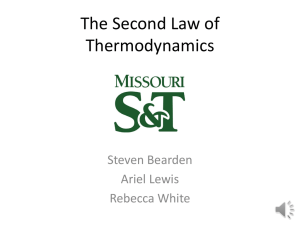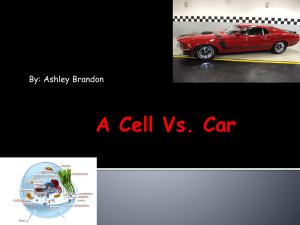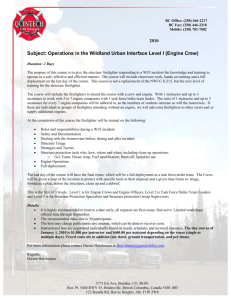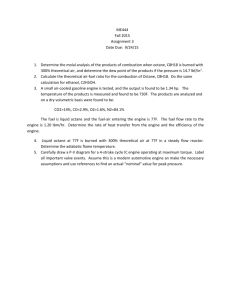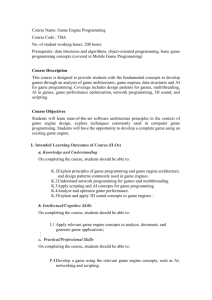Lesson 11: Engines II
advertisement
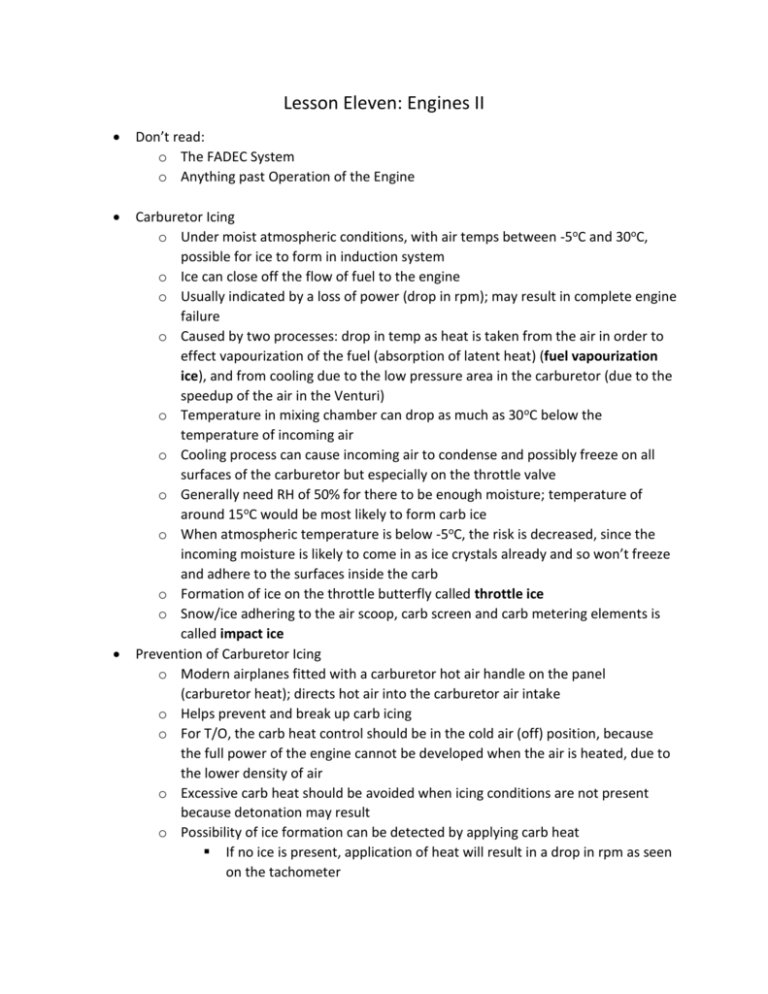
Lesson Eleven: Engines II Don’t read: o The FADEC System o Anything past Operation of the Engine Carburetor Icing o Under moist atmospheric conditions, with air temps between -5oC and 30oC, possible for ice to form in induction system o Ice can close off the flow of fuel to the engine o Usually indicated by a loss of power (drop in rpm); may result in complete engine failure o Caused by two processes: drop in temp as heat is taken from the air in order to effect vapourization of the fuel (absorption of latent heat) (fuel vapourization ice), and from cooling due to the low pressure area in the carburetor (due to the speedup of the air in the Venturi) o Temperature in mixing chamber can drop as much as 30 oC below the temperature of incoming air o Cooling process can cause incoming air to condense and possibly freeze on all surfaces of the carburetor but especially on the throttle valve o Generally need RH of 50% for there to be enough moisture; temperature of around 15oC would be most likely to form carb ice o When atmospheric temperature is below -5oC, the risk is decreased, since the incoming moisture is likely to come in as ice crystals already and so won’t freeze and adhere to the surfaces inside the carb o Formation of ice on the throttle butterfly called throttle ice o Snow/ice adhering to the air scoop, carb screen and carb metering elements is called impact ice Prevention of Carburetor Icing o Modern airplanes fitted with a carburetor hot air handle on the panel (carburetor heat); directs hot air into the carburetor air intake o Helps prevent and break up carb icing o For T/O, the carb heat control should be in the cold air (off) position, because the full power of the engine cannot be developed when the air is heated, due to the lower density of air o Excessive carb heat should be avoided when icing conditions are not present because detonation may result o Possibility of ice formation can be detected by applying carb heat If no ice is present, application of heat will result in a drop in rpm as seen on the tachometer If ice is in the carb, application of heat will remove the ice and permit the rpm in time to return to normal; will result in an initial further loss of power and engine roughness, before slowly returning to normal Roughness due to some water going into the engines; no big deal o Heat of hot air dependent on the heat of the exhaust An idling engine doesn’t have really hot exhaust, which is why you always apply carburetor heat before reducing power o Application of partial heat can be worse than full heat If the air is colder than -5oC, applying partial carb heat can bring actually warm up the air to within the temp. range of carb icing happening That’s why, if you’re using carb heat, you SHOULD use full carb heat o If a pilot in cruise at less than full throttle, is in an advanced stage of carb ice buildup: Apply full carb heat Apply full throttle Lean the mixture (why?) Move the prop pitch control to the full fine position In a worsening carb ice situation in which the engine is close to failing, attempt to restore power by priming the fuel Fuel Injection (in planes without carburetors) o Fuel is individually metered to each cylinder, as opposed to forming a mixture in a carburetor o Advantages More uniform distribution of fuel to all cylinders. Better cooling, through elimination of lean hot mixtures to some of the more distant cylinders Saving on fuel through more uniform distribution Increased power since the need to heat carb air is eliminated Elimination of hazard of carb icing o Difficult to start when engine is hot o Still susceptible to impact ice Exhaust System o Scavenging system that collects and disposes of the high temperature, noxious gasses that comes from the combustion of fuel o Prevents escape of those gases (like CO) to escape into the cabin o Utilized as part of a Turbocharging System The Ignition System o Function of the system is to supply the spark in the combustion stage of the 4stroke cycle o Comprises two “magnetos”, two spark plugs in each cylinder, ignition leads and a magneto switch A magneto is an engine-driven generator that produces an alternating current A generator is something which converts energy into electricity Source of energy is a permanent magnet o Polarity of a Magnet When a bar of iron is magnetized, it gets a north pole and a south pole Like poles repel, unlike poles attract Magnetic fields extend from north poles to south poles Magnetism and electricity are connected; if an electric current is passed through a conductor, a magnetic field will form outside the conductor If a conductor is made to cut the lines of a magnetic field, an electric current will be induced in the conductor A soft iron bar rotating will continually cut the lines of a magnetic field; if a coil of wire is wound around the bar, a current will be induced in the coil while the bar is rotating Produces an alternating current Rotating armature type magneto: a horseshoe magnet with a rotating soft iron core, wound with a coil of wire (armature), generating a low tension current by induction o Magneto Generates a low tension current as above Transforms to high tension Distributes the current to the individual spark plugs at the time when they need to be fired Contact breakers are located in the primary circuit; when the breaker points of the contact breaker is closed, the primary circuit is complete and the primary low tension current flows through breaker points to ground Magneto switch is located on the instrument panel and operates in the primary circuit; when an engine is switched “off”, the switch is closed; primary circuit is directly grounded and breaker points can’t function When “on” the magneto that’s on is allowed to fire, thereby generates a current o Dual Ignition Most aero engines have 2 spark plugs in each cylinder and 2 magnetos One spark plug in each cylinder is fired by one magneto; the other magneto fires the other set of spark plugs Possible to operate the engine on either magneto alone Purpose Safety; if one system fails, engine can still run Performance; improved combustion of the mixture increases power output and efficiency Magneto switch on the instrument panel allows the pilot to select either or both of the magnetos Failure of one magneto in a dual system will cause a loss in power of about 75 rpm o Shielding Metal covering which prevents ignition current interfering with the radio and other electrical parts o Ignition Timing Spark on modern high speed engines occurs early to allow complete combustion and max pressure to be developed when the piston moves down Means timing the magneto to fire at the right time The Electrical System o Includes everything that operates electrically with the exception of the magnetos which are driven by the engine for the purpose of producing current to the spark plugs o Ignition system NOT connected with the electrical system o Electrical system generally supplies power to start the airplane and to operate all systems needing electricity o Consists of a storage battery, with a solenoid (metal coil) activated by the master switch o Purpose of the starter motor is to turn over the engine so that it will start to operate; starter switch activates the starter solenoid which permits current to enter and drive the starter motor o Electrical system includes either a generator or alternator Purpose Supplies current to the electrical system Recharge the battery Alternators can produce a sufficient current to operate even at low engine speeds (taxing), whereas a generator will not begin to supply an appreciable amount of current until the engine is turning at a somewhat fast speed o Voltage regulator Prevents the generator/alternator from over-loading the system Prevents battery from becoming overcharged o Bus bar Receives the current produced by the generator/alternator and battery, distributes to the various parts needing electricity o Circuit breakers Fuses which protect electrical circuits Incorporated into the system to protect various components against damage caused by excess voltage and short circuits o Ammeter Measures the rate of flow of electrical current being produced; indicates whether charging or discharging of the battery is occurring o Generator warning light Indicates whether or not the generator is functioning o Most of an airplane’s electrical components are automatically activated when the master is turned on Those that are not, like the radio, should be turned “off” until after the engine has started Some radio equipment can be damaged by the voltage drop in the electrical system during starting when all power comes directly from the battery before the generator/alternator are regulating the voltage The Propeller o Function is to convert torque of the crankshaft into thrust (forward motion) o As it rotates, it moves forward along a corkscrew or helical path o Pushes air backward with the object of causing a reaction (Newton’s Third Law) in the forward direction o Props move a large mass of air backward at a relatively slow speed, in contrast to a jet engine o Propeller blade is an airfoil section Forces: thrust and torque Propeller torque refers to drag, which is different from crankshaft torque, which is the turning moment of the crankshaft When the propeller is revolving at a constant rpm, propeller torque and engine torque will be equal and opposite o Recall tractors and pushers o Pitch Defined as the distance in feet a prop travels forward in one revolution In a perfect fluid (without friction), the distance it would travel forward is called the theoretical or geometric pitch In real life, air has friction, so the practical or effective pitch is what should be expected Theoretical pitch – Practical pitch = Propeller Slip Angle at which the blade is set (like the AoI of wings) governs the pitch Coarse pitch o Blade is set at a large angle o Travels forward a greater distance with each revolution o Airplane will move forward at greater speed for a given rpm (like high gear in a car) o Best suited for high speed cruise and high altitude flight Fine pitch o Blade is set at a small angle o Less torque/drag and will consequently revolve at higher speed around its own axis, thereby enabling the engine to develop greater power (low gear in a car) o Gives best performance during T/O and climb Types Fixed pitch propellers o Pitch is pre-set during airplane manufacture o Trade-off between T/O performance and cruise performance o Plane generally outfitted with a tachometer to gauge engine output power Variable pitch propellers o Adjustable Pilot can change blade angle on the ground only o Controllable Pilot can adjust blade angle in flight manually Plane generally outfitted with a manifold pressure gauge o Constant speed Blades automatically adjust themselves to maintain a constant rpm as set by the pilot Plane generally outfitted with a manifold pressure gauge Read the rest of the section as to how they’re constructed and how they work Feathering In multi-engine airplanes, when one engine is stopped, generally good to feather the propeller on the dead engine (i.e. stop it from rotating) Achieved by changing the pitch to extreme coarse, where they are streamlined and cease to turn (i.e. blades parallel to airflow) Reduces drag on the blades, stops props from windmilling and prevents damage to defective engine Stops excessive vibration o Read the rest of the section on Prop Reversing and Care of the Propeller Engine Instruments o Oil Pressure Gauge Indicates oil pressure (in psi) supplied by the oil pump to lubricate the engine Oil pressure generated obtained at a point between the oil pump and a pressure regulating valve Should be checked immediate after engine has been started If oil pressure doesn’t register within 10 s after engine starting, engine should be shut down and checked Engine with cold oil, oil pressure gauge will read high As engine warms up, oil will warm up, and eventually pressure will decrease back to normal If pressure remains high for a long time, engine is not getting proper lube High oil pressure will force oil into the combustion chamber; can cause smoking and damage Low pressure means that there will be no film of oil at all between the working surfaces of the engine and metal will be rubbing on metal o Oil Temperature Gauge Normally located next to the oil pressure gauge Gives reading of temp of oil in degrees F or C In starting an engine with cold oil, pressure gauge read high, oil temp gauge reads low As oil warms up, both instruments will approach their normal readings An abnormal drop in oil pressure and coincident rise in oil temperature is a sign of trouble! However, even if the pressure shows no marked rise or fall, if oil temp shows a rise, there may be excessive friction or overload in the engine Low oil temp is undesirable too; cold oil does not circulate freely and may cause scoring of the engine parts Low temperature would be accompanied by a rise in pressure o Read Cylinder Head Temperature Gauge, Carb. Air Temperature Gauge, Outside Air Temperature Gauge o The Tachometer RPM indicator, shows the speed at which the engine crankshaft is turning in hundreds of revolutions per minute Generally found on fixed pitch prop planes; only instrument that displays information about engine power being produced Power output absorbed by a fixed pitch prop is proportional to the cube of its rpm; throttle controls the rpm On planes with a controllable pitch or constant speed prop, both the tachometer and the manifold pressure gauge display engine power information RPM settings, recorded on the tachometer, would be controlled by the propeller control; manifold pressure settings would be controlled by the throttle Tachometer markings Green arc indicates normal range of operation o RPM settings within this range should be used for continuous operations o Should apply carb heat if powering down below the green arc while cruising/descending Yellow arc indicates caution range in which there is a possibility of engine damage under certain conditions Red line is max limit o The Manifold Pressure Gauge Found on planes with a controllable pitch or constant speed prop Usually located adjacent to the tachometer Intake manifold is the part of an engine that supplies the fuel/air mixture to the cylinders Indicates in inches of mercury the pressure of the fuel/air mixture in the engine intake manifold at a point between the carburetor and the cylinders On constant speed props RPM setting will remain constant since the propeller automatically changes its pitch to maintain the desired engine speed Manifold pressure gauge therefore is the only instrument that records fluctuations in the engine power output (affected by the throttle) Important for determining proper throttle settings and it is the instrument which will indicate power loss from occurrences such as carb ice When the engine is not running, reading on the MPG will be that of existing atmospheric pressure When the engine is running, pressure inside the intake manifold is lower than that of the outside atmospheric pressure because the pistons create a partial vacuum On a turbocharged or supercharged engine, the pressure inside the intake manifold is higher than outside the atmospheric pressure and readings will be higher than those on normally aspirated engines When the prop itch control is moved during flight from fine pitch (high rpm) to coarse pitch (low rpm) position, without an accompanying adjustment of the throttle, the manifold pressure gauge will register an increase When the rpm is decreased, the engine turns more slowly speed of flow of fuel/air mix through the manifold system is decreased Pressure increases by Bernoulli’s Principle, hence increased reading on the manifold pressure gauge. When increasing power, increase the rpm first and then the manifold pressure. When decreasing power, decrease the manifold pressure first and then the rpm. Read the rest of the section on Manifold Pressure and Power and Humidity and Power


